

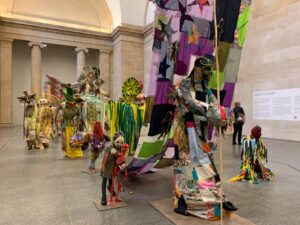
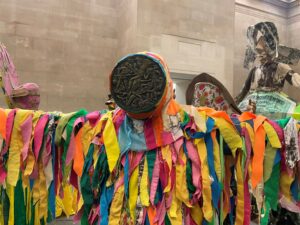
On our trip to London one of the most exciting experiences was seeing Hew Locke’s “Procession”
filling the central court of the Tate Britain with its brilliant collaged figures entirely constructed from recycled materials.
The Tate is on the site of a former prison, which I wrote about in 2017. Now we see it as the product of capitalism and specifically the exploitation of black labor in the sugar industry. Henry Tate was a sugar magnate.
Hew Locke: The Procession “What I try to do in my work is mix ideas of attraction and ideas of discomfort-colourful and attractive but strangely, scarily surreal at the same time.”
The Procession has 150 figures, no two are the same
It includes painting, drawing, printmaking, sculpture. It is entirely imaginary, there is no particular culture or mask quoted. The Procession can be almost a funeral.
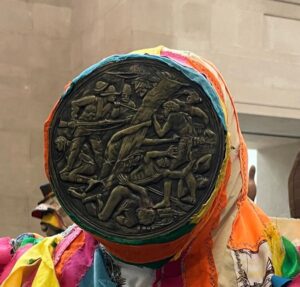
Celebration, worship, protest, mourning, escape Imaginary people
Starting point Henry Tate, sugar refining magnate. “reflect on the cycles of history and the ebb and flow of cultures, people, finance and power.”
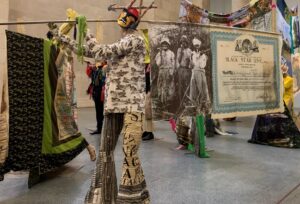
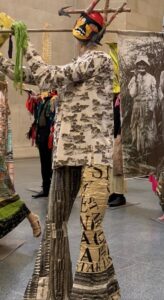
Note the pants on this figure. It is the famous image of the Middle Passage
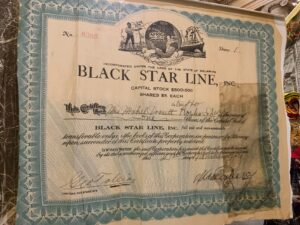
The famous Back to Africa movement led by Marcus Garvey used these certificates for joining
The artist bought shares from dead companies included the Black Star line.
Text below is from Tate:
“The figures travel through
space but also through time. They carry historical and cultural baggage: the evidence of global financial and violent colonial control embellishes their clothes and banners.
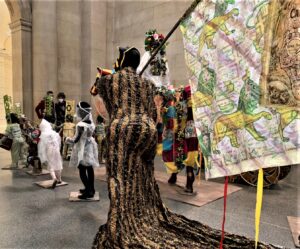
This figure with the striped dress has a cat head. See next image
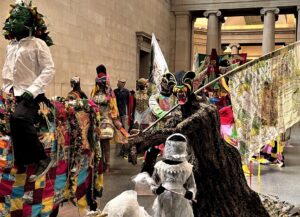
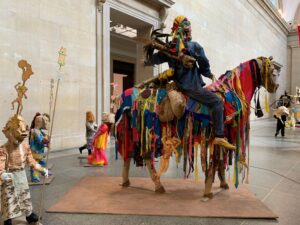
“Images of the colonial architecture of Locke’s childhood Guyana emblazon the flags and their bearers, its flooded fields and rotten wooden walls vanishing under rising sea levels. Despite this, their attire and stance suggest power and self-assertion.

Chest labelled East Indies Sugar
Locke occupies a space that was founded from wealth derived form an industry built on the labour of enslaved African people and their descendants and which subsequently relied on the indentured labour of Asian people”
Here is a misshapen globe
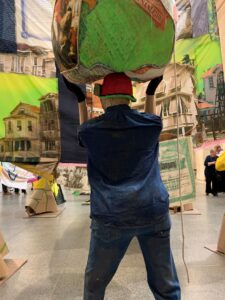
Locke says he “Makes links with the historical after-effects of the sugar business, almost drawing it out of the walls of the building.”
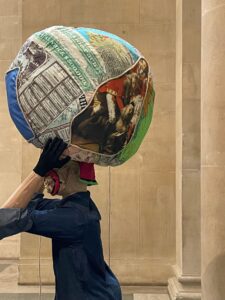
“The Procession” also carries Locke’s own past artistic journey with imagery linked to his previous work incorporating statues, rising sea levels, Carnival and the military.
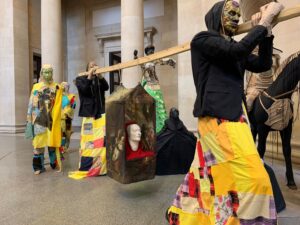
Leonardo self portrait inside the niche. Cut up Benjamin West painting on another
“While being marked by history, The Procession’s participants are not constrained by it. These fragments come together to usher new meanings and sensations, stirring collective memories, fears and desires.”
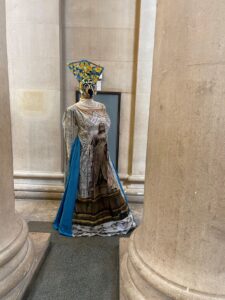
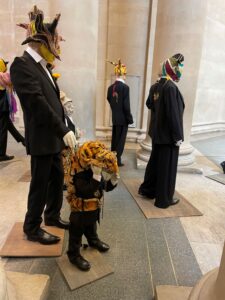
“The work evokes real events and histories and yet presents them as aesthetic fiction. As we join “The Procession” and Locke’s artistic imagination begins to work on us, the figures invite us to walk alongside them for a while, into an enlarged vision of an imagined future.”
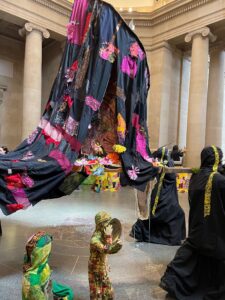
“The influences of both Indian and Indo-Caribbean culture can be seen in The Procession, as in much of Locke’s work to date. It is unclear whether the procession participants are wearing masks or if these are their true faces. Several figures and costumes within the Procession reference specific Caribbean Carnival characters from across the region.
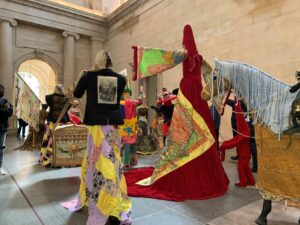
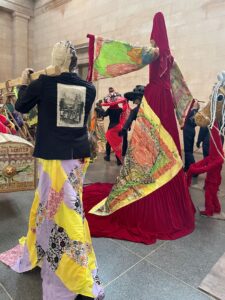
These include Mother Sally in her voluminous dress, Midnight Robber, wearing a huge brimmed hat, Pitchy Patchy, dressed in a suit made of tattered, colourful pieces of cloth and Sailor Mas, inspired by British, French and American naval staff. Each has its histories and its portrayal differs across the Caribbean”
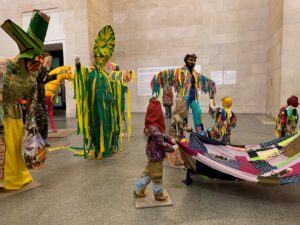
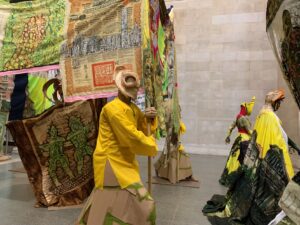
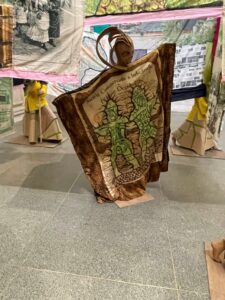
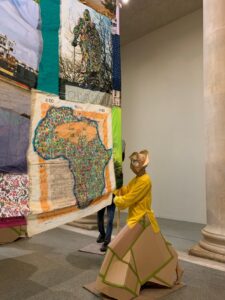
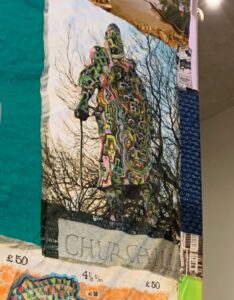
Churchill statue in background that artist has covered with graffiti
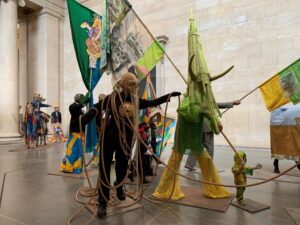
This suggests the climate crisis another Locke theme
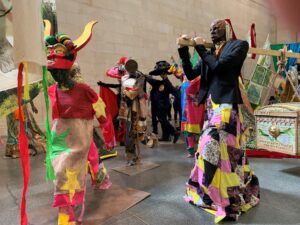
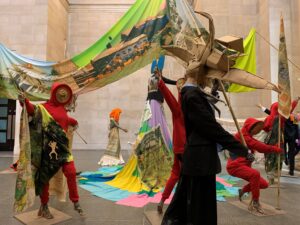
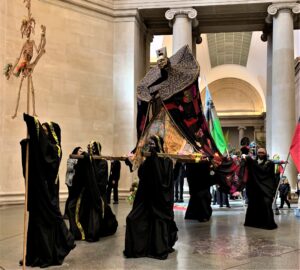
I will stop here. It is impossible to actually take it all in.
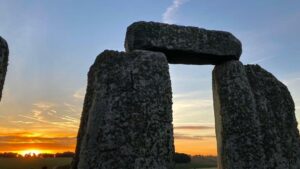
Right after we arrived in London, we went to the Stonehenge exhibition at the British Museum. I got free press passes for me, Henry and Henry’s sister, Imogen.
There were so many amazing aspects to this display that it is impossible to convey the depth and extent of the experience. Not to mention the complexity of the information provided.
Stonehenge was constructed at around the same time, 4,500 years ago, as the Sphinx and the Great Pyramid of Giza in Egypt.
The exhibition spanned the
Mesolithic (c. 12,000–6,000 years ago),
the Neolithic (c. 6,000–4,500 years
ago) and
the Bronze Age (c. 4,500–2,800 years ago).
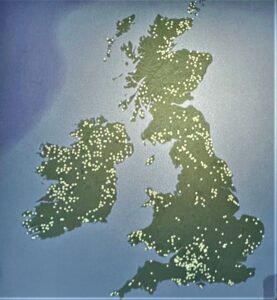
Here is the first image in the Stonehenge exhibition at the British Museum. I took a still from the video that shows how many Neolithic sites have been found in the United Kingdom. The exhibition also includes work from Europe. This photo shows most of the 1300 sites discovered in the UK, it does not include Brittainy. The first alignments with the solstice have been located as dating to 3700 BC
“Stonehenge’s significance changed enormously about 4,000 years ago, as it gradually became the central point around which hundreds of burial mounds were raised. Across Britain and Ireland during this period the importance of death and the role of grave goods in expressing ideas and identities reached its peak” cat p. 20)
The early societies were connected to nature, to the heavens and to one another.
There was an overall trajectory from peaceful, celestial worshipping communities, to, farmers, to guess what, social hierarchies based on wealth and then marking territory and warfare. the transition from stone to metal was a key moment for the change from communal society to individualism.
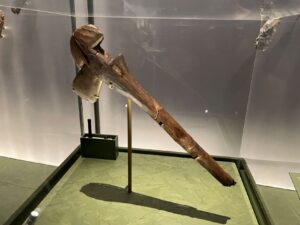
A polished axe made from porcellanite from County Antrim, Northern ireland, and deposited in a bog c. 3500–3000 BC Shulishader, isle of Lewis, Outer Hebrides, Scotland Porcellanite stone and rosaceous wood (hawthorn or apple),
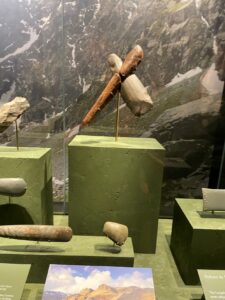
Beautiful display of stone axes.
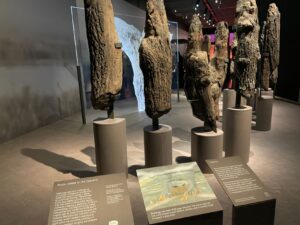
Seahenge wooden circle found in Norfolk created 2900BC
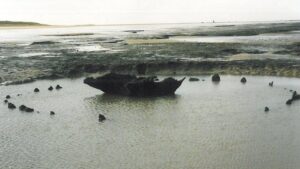
In situ Seahenge Norfolk 1998 copyright David Robertson
I realized as I was writing this that I visited a Neolithic burial site with my 87 year old mother in law in 1995 at Barclodiad y Gawres (Welsh for “The Giantess’s Apronful”) near Aberffraw in Anglesey
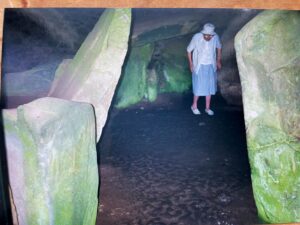
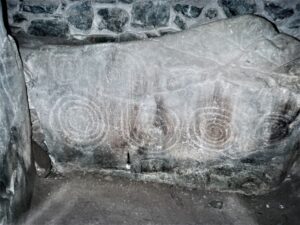
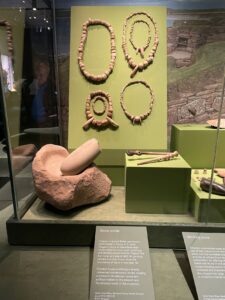
Necklaces ivory bone and tusk Finds from Skara Brae, c. 3100–2500 BC Skara Brae, mainland, orkney, Scotland
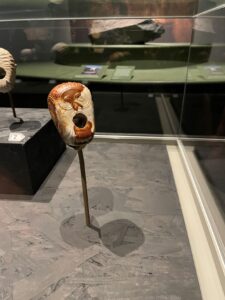
The Knowth decorated mace-head, Flint c. 3500–3000 BC Knowth, County Meath, Republic of Ireland
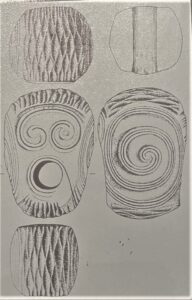
Elaborate relief incised into flint. These extraordinary objects were so beautifully displayed!
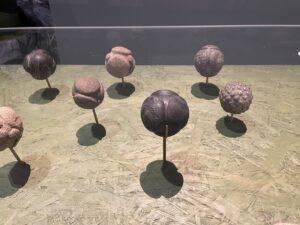
The Towie decorated and carved stone balls, c. 3000 BC Towie, Aberdeenshire, Scotland Stone, diam. 7.3 cm National Museums Scotland,
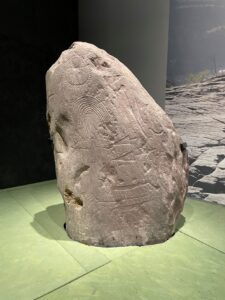
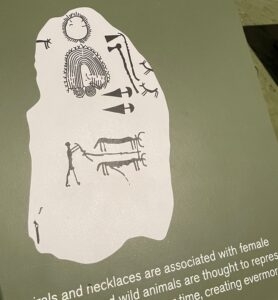
These incised stones were found in the open air, not in a burial.
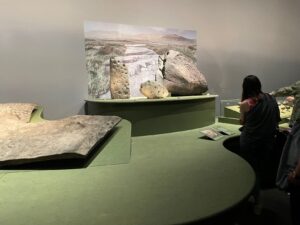
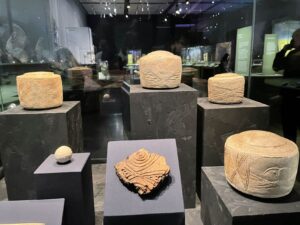
the Folkton ‘drums’ or cylinders, found with the burial of a child, c. 3000 BC Folkton, north Yorkshire, england Chalk, H. 11.9 cm, diam. 14.4 cm (largest piece), H. 8.3 cm, diam. 10 cm (smallest piece) British museum, 1893
Now we move on to the age of metal and gold, a significant change in the society. Status comes in!
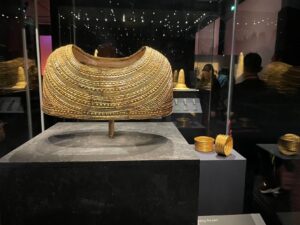
Lunula, 2400–2000 BC Blessington, County Wicklow, Republic of Ireland Gold, diam. 22.1 cm British Museum, WG.31 Donated by John Pierpont Morgan
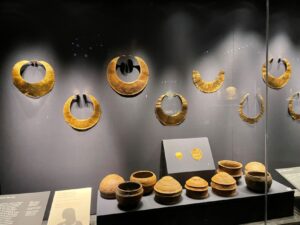
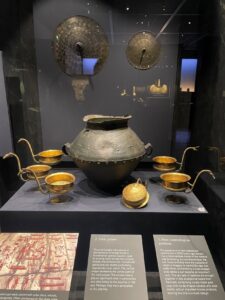
The Mariesminde hoard, c. 1000–700 BC Mariesminde Mose, Funen Island, Denmark Bronze and gold, H. 20.5 cm, W. 14 cm (each cup), H. 35 cm, W. 42 cm (vessel) National Museum of Denmark,
Those conical bronze shapes on the wall were placed on women’s stomachs in Scandianavian graves. THey are covered with symbols of sirals and sun motifs symbolizing regeneration and rebirth. The connical shape represents the center point of the sun’s power.
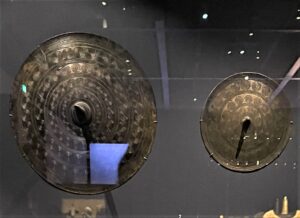
Here is the most exciting and beautiful piece in the exhibition!
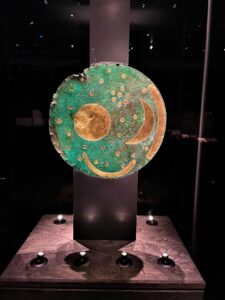
The nebra sky disc, buried c. 1600 BC nebra, saxony-Anhalt, Germany Gold and bronze, diam. 32 cm state offi ce for Heritage Management and Archaeology saxony-Anhalt, Halle, Hk
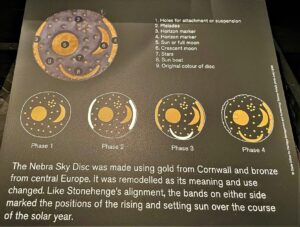
This sky disc was one of the most exciting pieces in the exhibition
It gives us the subtlety of the early understanding of constellations, and in its materials, speaks of the exchange of goods over long distances, It included bronze from Central Europe.
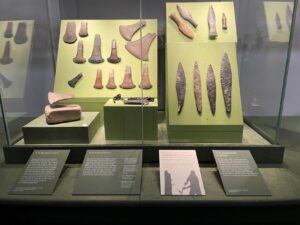
Axe heads 1700–1500 BC Arreton Down, Isle of Wight, England Bronze, L. 17.2 cm, W. 9.9 cm
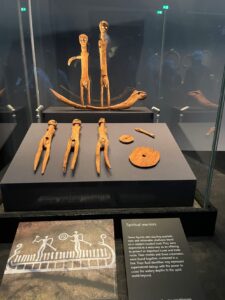
Spiritual Warriors on Serpent headed boat
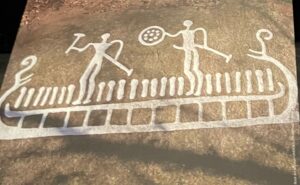
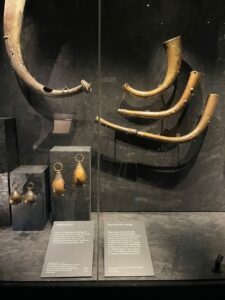
Horns and bells , bronze, Dowris hoard, 950–750 BC County Offaly, Republic of Ireland
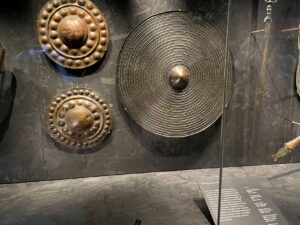
Shields, bronze, Isis River, oxfordshire, england diam. 34 cm British Museum, Rhyd-y-Gorse, Ceredigion, Wales, British Museum,
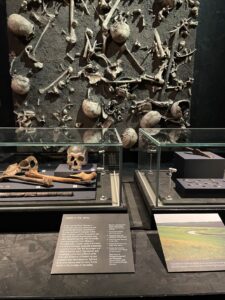
the grim conclusion of a battlefield
The British Museum did a stunning job of installing, sequencing, and explaining these sometimes esoteric objects. They carefully gave equal privilege to the humble works of ax heads and the gold necklaces. They also gave us a sense of what holds a society together ( a shared belief system) and what makes it fall apart, land cultivation, property, then competition, individualism, and finally warfare.
But there were also protests. Shockingly there is a plan to build a road under Stonehenge


As well as BP sponsorship of the exhibition and the British Museum in general On the right it describes how BP while sponsoring this exhibition is simultaneously destroying indigenous Rock Art in Murujuga Western Australia 10 times older than Stonehenge
and much more: the issue of repatriation and the effects of the cllimate crisis on communities most affected by BP
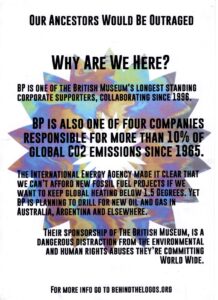
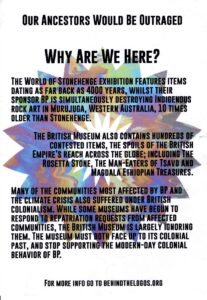

The image behind the text is a reworking of BPs sunny greenwashing logo which is why this group is called behindthelogos.org
Just in case that isn’t enough bad news about BP, I read today on the site “We Don’t Have Time” a post that said
“BP to ramp up oil output, inaugurate U.S. Gulf platform in 2022 BP (NYSE:BP) expects to double crude oil production from its Thunder Horse project in the U.S. Gulf of Mexico and launch its latest production platform by the end of this year”
The company expects to produce ~200K boe/day by year-end 2022 from the current 100K boe/day at Thunder Horse, according to Starlee Sykes, BP’s Senior VP for the Gulf of Mexico and Canada.
BP (BP) also is preparing to start its fifth operated platform this year – Argos – the centerpiece of its $9B Mad Dog 2 project in the Gulf, but Sykes declined to specify in which quarter production would start.
“More Gulf of Mexico oil and gas helps improve emissions globally,” Sykes said, according to Reuters.
Last September, BP (BP) announced the start-up of Thunder Horse South’s phase 2 expansion and said a total of eight wells would be drilled to increase oil and gas production to ~400K boe/day by the mid-2020s.”
**************************************************
As Neolithic Art is an area far outside my expertise, it was fortuitous that as soon as I got back to Seattle, I went to a symposium about Nancy Holt’s Rock Rings 1977-78 at Western Washington University.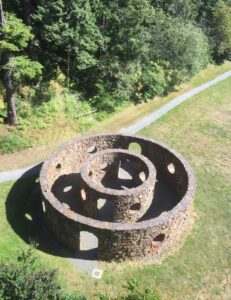 ,
,
which draw on her exploration of Neolithic sites that she visited with Smithson in 1969 as well as her interest in celestial constellations and stone construction. They were completed after her more famous Sun Tunnels, and only four years after Smithson’s death. They align with Polaris the North Star. Her Sun Tunnels, 1973-76, like Stonehenge, align with the Summer Solstice.
Rock Rings is constructed of Triassic era Schist.
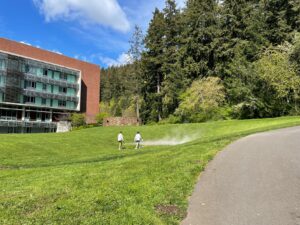
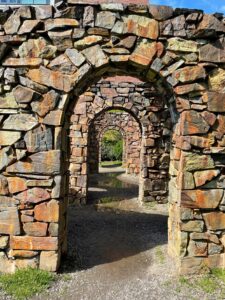
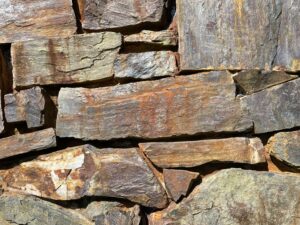
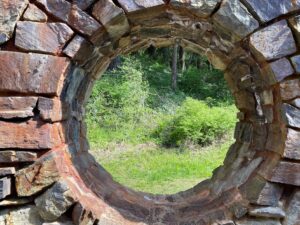
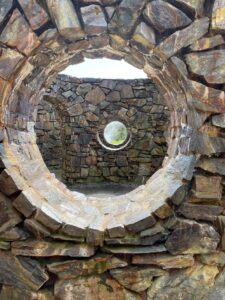
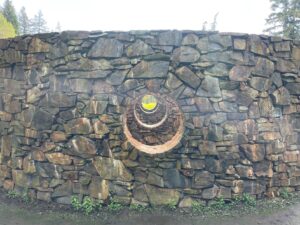
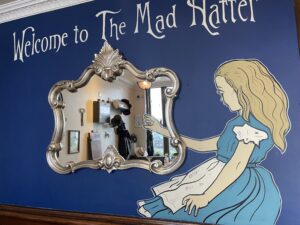
For my first blog post on our exciting trip to London I feature our special hotel The Mad Hatter! As we checked in we were welcomed by Alice through the Looking Glass, literally. her hand enters a mirror which reflects the check in desk. Behind the desk was a large hat!
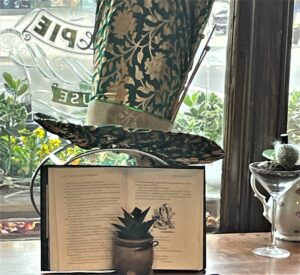
So why the Mad Hatter.? –
As this sign declares, “Southwark was the centrer of hat production for hundreds of years. Due to poor factory conditions hat makers were exposed to mercury in felt. Today we know that mercury poisoning causes dementia-lik symbtoms, but int he 19th century people assumed hat makers were all “mad” drunks, hence the phrase “mad as a hatter” which is wehre ourname comes from. This was famously satirzed by Lewis Carroll’s eccentric character The Mad Hatter. ”
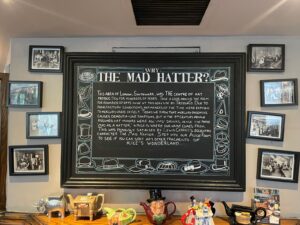
On the ceiling of the dining room we had the Mad Hatters Tea Party
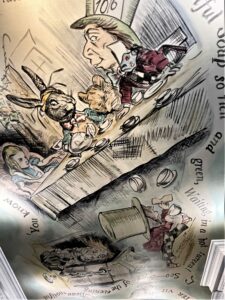
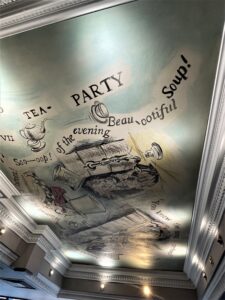
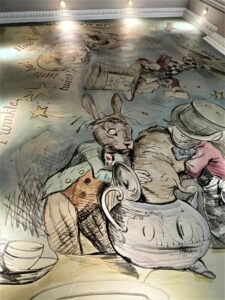
On one window the mural blocked the view of the construction nearby
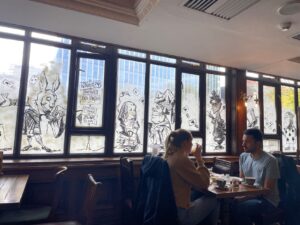
In the pub each booth had a different topic
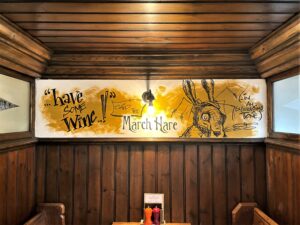
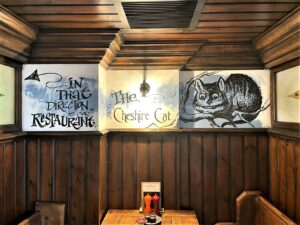
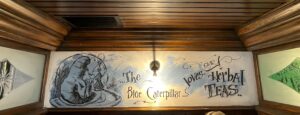
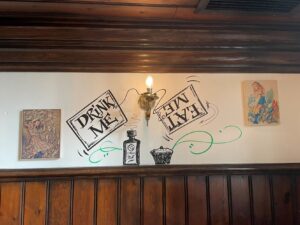
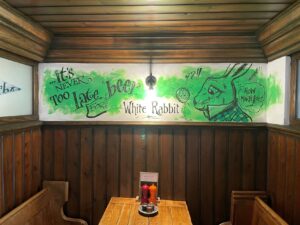
Near the elevator, the descent to the rest rooms
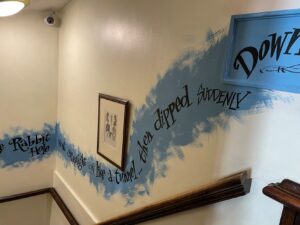
In our bedroom we had some playing cards over the bed
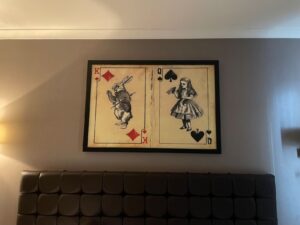
View out the window. Insane development of high rises near by and in every direction
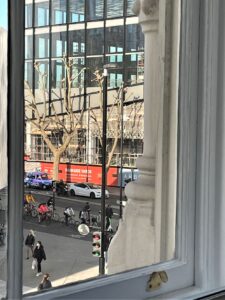
The Thames River Walk was only a block away
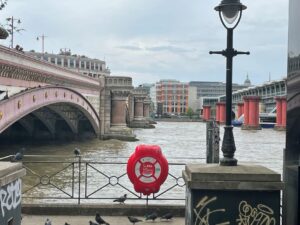
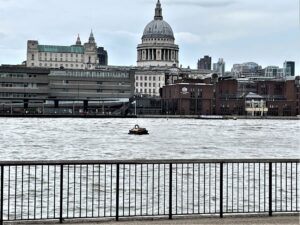
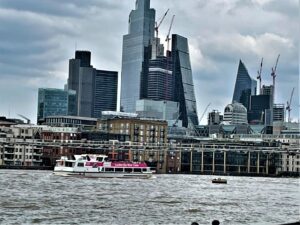
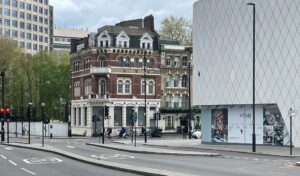
Our little hotel amid the development around it.
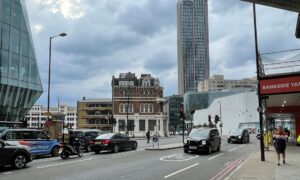
Alms Houses overshadowed by giant skyscrapers
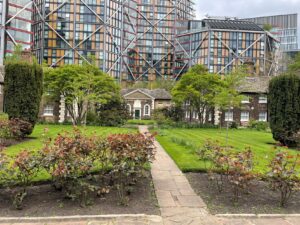
Another view out our window in another direction
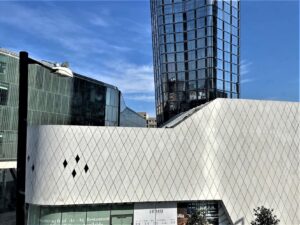

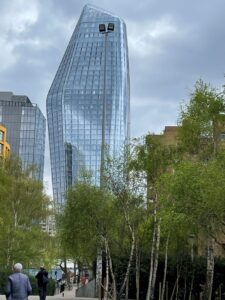
This small hotel is holding its own amidst so much development. Be sure to stay there if you go to London! It is super well located with a short walk along the Thames to the Tate Modern and the Haymarket, not tomention the National Theater where we saw the play “Small Island”
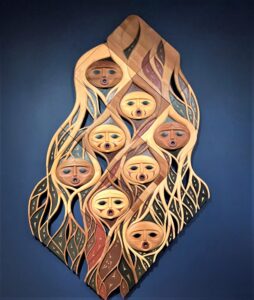
Canadian (Musqueam First Nation) Susan Point’s The First People suggests one theme of the amazing exhibition “Our Blue Planet:Global Visions of Water” at the Seattle Art Museum only until May 30.
Made of red and yellow cedar the piece seems to speak to us of both survival and sorrow, as these faces, each one distinctly different, call or perhaps sing to us with their rounded mouths as they float in interconnected streams.
The artist states:
“I am mostly inspired by nature and our connected human spirit. I try to illustrate our need to protect and restore our natural treasures and bring reflection and awareness to issues of concern in all our lives.”
“Our Blue Planet: Global Visions of Water” suggests that as it encompasses 92 works of art from 17 countries and seven native tribes.
During the pandemic three curators at the Seattle Art Museum assembled “Our Blue Planet: Global Visions of Water” with 74 artists from 17 countries and seven Native American tribes. It draws entirely from the museum’s permanent collection and loans from local collectors.
The curators, Pamela McClusky, Curator of African and Oceanic Art, Barbara Brotherton, Curator of Native American Art, and Natalia Di Pietrantonio, newly appointed Assistant Curator of South Asian Art, created ten themes that refer to water as necessary to life, as pleasure, as law, as mythic and as desecrated. They encompass celebration, poetry, ritual and catastrophe.

We are greeted at the entrance with a video of Ken Workman, a direct descendant of Chief Seattle, welcoming us, in the Lushootseed language.
It is moving and appropriate that he is standing on the shores of the Duwamish River as he greets us, the river of plenty before white colonizers arrived, and now a Superfund site and industrial wasteland.
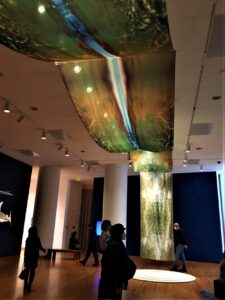
Immediately after Workman’s greeting we look up to see Carolina Caycedo’s fifty-foot banner that charts the change in a river from healthy to polluted, signaling the theme of the exhibition in one dramatic statement. Caycedo considers rivers as living and spiritual.
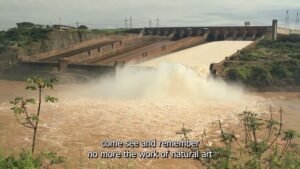
Caycedo’s video “A Gente Rio: We River” 2016 brings us the voices of the people living on the Paranà River as they explain their traditional ways as well as the devastating impact of the Itaipu Dam on the border of Brazil and Paraguay, completed in 1984. But these people have also protested. They know exactly why the dam was built: the result of corporate impunity.
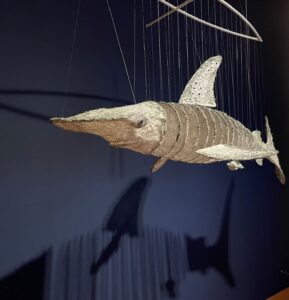
Nearby is a hammerhead shark, hung at our eye level so we can look right into the eyes of its hammer shaped head. The Ghost Net Collective on the Erub islands (Northeast of Australia) call attention to the lethal presence of the nets with these sculptures.
Here are the ten themes of the exhibition.
“Rains that Flood and Hypnotize”
“Rivers and Canoe Journeys That Sustain Life”
“Oceans with Bodies Like Our Own”
“Pools of Pleasure and Reverence”
“Patterns of Water”
“Future Waters Through the Eyes of Women and Children”
“Where Water is Law in Northern Australia”
“Sea Creatures that are Honored and Endangered”
“Tragic Memories of Global Trade”
“Mythic Vision form Water’s Creation to Regulation”
“Desecration of Our Troubled Waters.”
Speak them out loud and they form a poem to water and the ways it intersects our lives, present, past and future. I will touch on a few of them here.
“Rivers and Canoe Journeys That Sustain Life”
As we enter the next gallery, we are greeted by the regalia created by Danielle Morsette “Colors of the Salish Sea Ensemble” . It is to be worn for an honorary stop on a canoe journey.
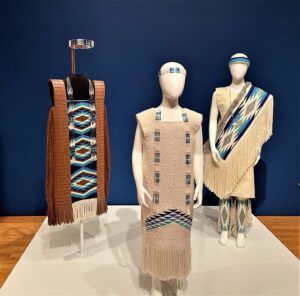
Here in the Northwest we have joyfully welcomed the return of the canoe journey beginning in 1989 . Tribes travel the ancestral sea routes of their cultures to a host tribe. It has particularly revitalized the youth in many native cultures. Twice I have been lucky to be visiting a Native Community as it formally welcomed participants on the journey with music, dance, and shared food.
Three videos by Tracy Rector (Mixed race/Choctaw/Seminole) Managing Director of Storytelling, Nia Tero Foundation celebrate indigenous resilience and the beauty of the land, sea and sky, their music, their poetry, their regalia. The artist states:
“80% of all biodiversity is on Indigenous-held territories. The world is healthiest where Indigenous People are actively living, thriving and being ‘in community.’ This [stewardship] is essential in saving the health of our planet.”
“Rains that Flood and Hypnotize”
Rain is both a blessing and a threat. It sustains us and our food, but it can overwhelm us as we have seen increasingly often. In this section the images include a compelling photograph by Raghubir Singh of four women huddled together in a monsoon downpour, that particular type of rain in India that is welcomed, but also frightening. We see an image of flooded fields nearby by Raghu Rai After flash floods near Jaipur, as the label states “The water rapidly gathers in shapes like lightning across the ground and around stunted trees, devastating the environment.”
But another work from South Asia in the indigenous Mithila style by artist Amrita Das depicts the dramatic effects of the 2004 tsunami in Sri Lanka as people’s villages are wiped out entirely ( For a literary description of this same tsunami read Amitav Ghosh, “A Town by the Sea” in Incendiary Circumstances, 2006)
Patterns of Water
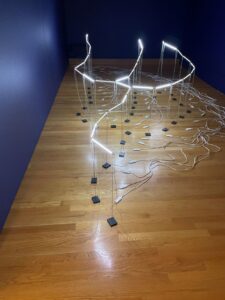
Claude Zervos gives us the Nooksack River in cathode ray tubes, suggesting its underground networks. Zervas has spent years next to this river and watched it degrade as it was dammed.
“Waves” by Ogata Korin a large Japanese screen evokes the rolling sea
“The Roar of the Sea” by Suzuki Masaya suggests the sound of the sea through an intense process of laquering mother of pearl. 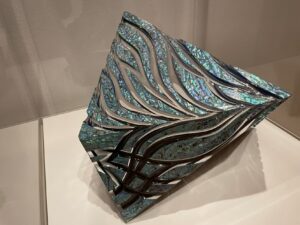
“Oceans with Bodies Like Our Own”
Seeing global nomad artist Paulo Nazareth’s lying on a beach suggests the peace that we all experience, lulled by the sound of the sea. But he is only briefly resting on his year long journey walking barefoot from Brazil to New York.
“Pools of Pleasure and Reverence”
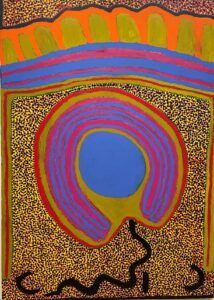
The dramatic image of Kurtal by Australian aboriginal artist Ngilpirr Spider Snell represents a spirit snake who “lives in a sacred waterhole called a jila. This desert spring is the only reliable source of water in all seasons . . . Kurtal is the moral protector of the right to use it and the land around it. …”
For a visit to Kurtal with Spider Snell, watch a trailer of Putuparri and the Rainmakers, by Nicole Ma
“Future Waters Through the Eyes of Women and Children” has some of the most provocative imagery in the exhibition. Tuan Andrew Nguyen’s video imagines a future world in which children collect the detritus of what we have left behind and create rituals with them. Here a child speaks to a head which becomes human, then a head again, and she takes it into the sea and burns it.
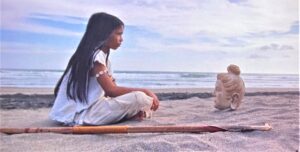
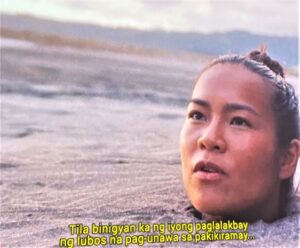
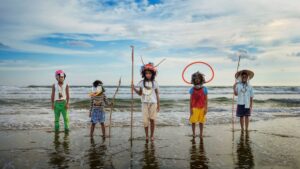
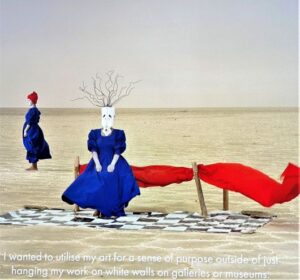
Also in this segment a still and a film by Ethiopian Aïda Muluneh, reenacts the process of getting water for survival in Dallol, northern Ethiopia, one of the hottest and driest places on Earth. Here is a view of it
As Muluneh explained:
“While travelling across Ethiopia for my work, I often encounter streams of women traveling on foot and carrying heavy burdens of water . . . women spend a great deal of time fetching water for the household.”
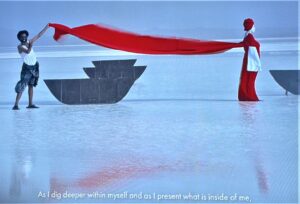
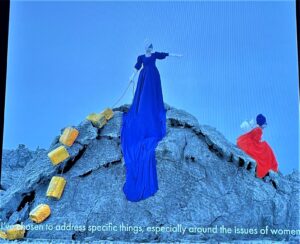
“Where Water is Law in Northern Australia” highlights four works on found aluminum by well known aboriginal artists, a dramatic departure from traditional eucalyptus, only seen here. The abstract patterns refer to law, ritual, ancestral power, clan designs, and, of course, the patterns of water.
“You are paper. We are sacred design. You make paper. Your wisdom is paper. Our intellect is sacred design, homeland, and ancestral knowledge of ancient origin. By painting these designs, we are telling you a story. From time immemorial we have painted just like you use a pencil to write with.” —Dula, Nurruwuthun (1936–2001), traditional leader of northeast Arnhem Land, 1999
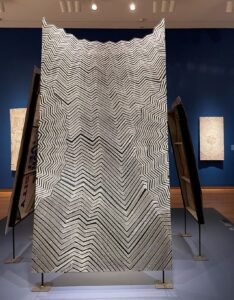
Here you see Garrapara2018 by Gunybi Ganambarr,
Australian Aboriginal, Ngaymil clan, Northeast Arnhem Land. Ganambarr began painting after being told by an elder, “This is my wisdom. I’ll hand it over to you. Take it! Sit with us and live this life.” He says, “Soon I was learning the Yolngu side of deep significance… the foundations of the deep identity of the world.” The wavy designs refer to a specific bay and speak of clan affiliations.
Learn more here
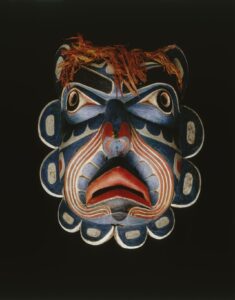
“Sea Creatures that are Honored and Endangered” The Mask of Ḱumugwe’(Chief of the Sea) from the Kwakwaka’waka rules over the water and this section that includes a sea turtle, a hammerhead shark (seen in the opening gallery), a sea bear and a sawfish. Both the shark and the saw fish are created in three dimensions from the fishing nets that are choking the sea.
Nearby is a bronze turtle called Dadu Minaral (turtle), 2007 by Dennis Nona from the Torres Straits (48000 kilometers, 1200 coral reefs at the northern end of the Great Barrier Reef, off the coast of Australia). Here the artist represents an historic initiation rite, by impaling the turtle on poles, but today the Torres Straits indigenous peoples are pioneering ecological partnerships to preserve this huge marine ecosystem.
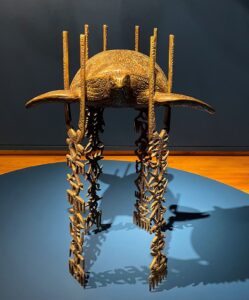
I love this image of the whale fish vomiting Jonah by Jarinyanu David Downs
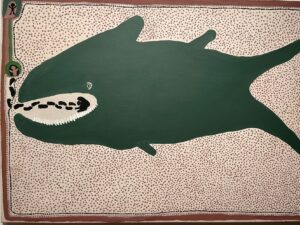
And here is the sawfish by Syd Bruce Short Joe . It is also endangered
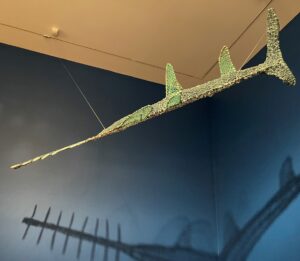
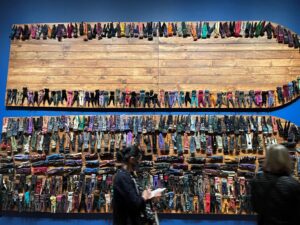
The highlight of “Tragic Memories of Global Trade” is the reinstallation of Marita Dingus’s intense homage to the slave trade- 200 Women of Afrrican Descent and 400 Men of African Descent. The artist created each headless body over year and a half as a meditation on the atrocities of slavery. The work as been reinstalled to correspond to the diagram of The Brooks, a slave ship on the late 18th century.
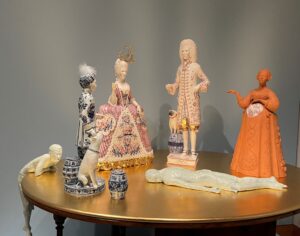
Not far away is an installation by Claire Pardington of two elegant 18th century figures drinking tea surrounded by slaves and sailors. She suggests the different status with two techniques, Limoges and porcelain, as well as the cost in human lives for the tea trade and the thirst for Chinese ceramics.
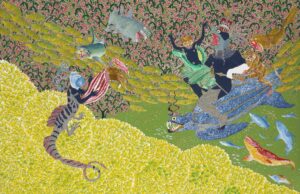
“Mythic Vision from Water’s Creation to Regulation” features Raqib Shaw’s The Garden of Earthly Delights V” showing an underwater world that is both beautiful and frightening in its fantasy and riff on Bosch’s famous painting. According to the curator “Beneath Shaw’s kitsch aesthetic lies his personal sorrow and his memories of fleeing Kashmir with his family. His idea of paradise is thus grounded in the physical and real space of Kashmir.”
“Desecration of Our Troubled Waters”
Among these works is a photograph by La Toya Ruby Frazier of the horribly polluted Braddock, Pa. where she grew up. Her Ted Talk talks about her work in Flint Michigan.
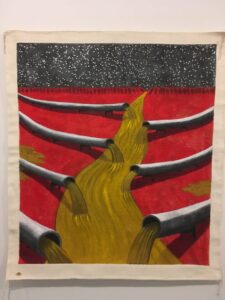
John Feodorov’s dramatic painting Desecration no. 2, represents pipe lines spilling pollution on native lands. Master Weaver Tyra Preston created special plain white Navaho rugs for the artist on which he painted, with some trepidation given the rugs’ powerful importance as metaphor of land and culture.
The exhibition includes so many more works that we see with new eyes from various parts of the museum. The rethinking of the idea of an exhibition brings together different cultural expressions to demonstrate that water is our shared concern, and necessary to our shared survival. In that way, the Indigenous voices are the most resonant in their respectful and deep understanding. But seeing their work and their voices placed among so many other cultures demonstrates the interconnectedness of everyone on the planet.
Finally, the curators reach out to our community:

“Our Blue Planet” is truly a groundbreaking exhibition.
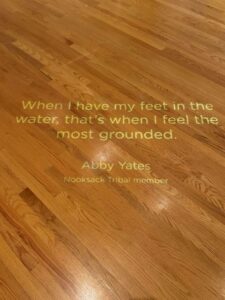
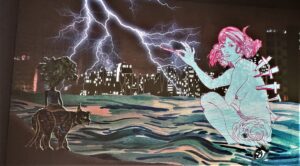
Natalia Di Pietranto, the new Assistant Curator of South Asian Art at the Seattle Art Museum explains her first exhibition “Embodied Change, Asian Art Across Time” as follows
“I wanted to . . . explore how the body is a site of both personal intimacy and possibility for change. . . I hope that visitors come away with a sense of how these artists are boldly imagining personal, political, and social change.”
The selection of artists covers a vast time span from the Indus Valley/Harappan era ( 3rd century BCE to 2nd Century CE) to the present moment. And in the first gallery, we see that time frame immediately, juxtaposed by the artist Chitra Ganesh, who selected early female goddess figures to be shown with her 2022 video Before the War. She is celebrating the transformation of historical goddesses into contemporary questing women in her video
(see top of post and below), drawn from comic books she read as a child on Hinduism.
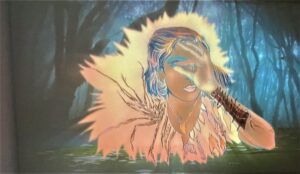
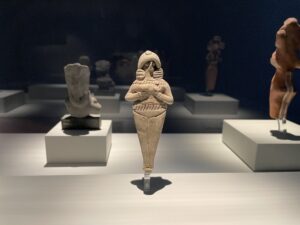
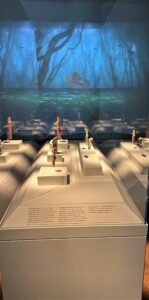
In the next gallery, a startling series of works includes Humaira Abid’s wonderful carved wood sculpture with a political punch. Here you see a suitcase made of wood with two shirts, a skull cap and prayer beads, as for a religious traveler. Beside it is a gun. The piece is called Sacred Games. The gun sits there silently, unrelated to the peaceful suitcase and yet awaiting our own interpretations and anxieties.
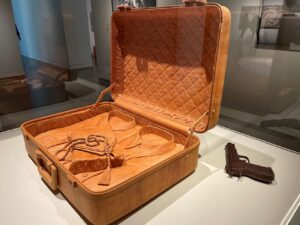
In this gallery are F.N. Souza’s Self Portraits and Adeela Suleiman’s amusing helmet that includes a tiffin (lunch) box.
The Pakistani artist Nazia Khan has a Cage-corset, 2007 corset as well as photos of a performance in which she wears various corset like garments.
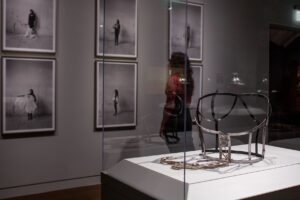 y
y 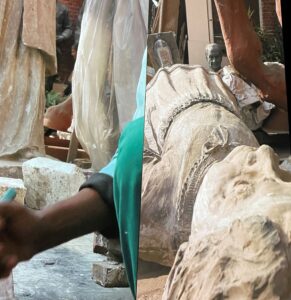
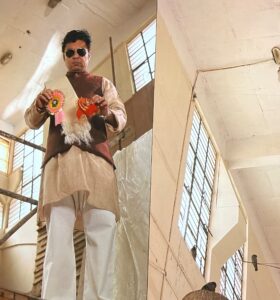
I loved the video by Bani Abidi Death at a Thirty Degree Angle. It gives us the art studio of a long time maker of commemorative statues, here filled with various stages of creation. In struts a local politician ready for his statue. As he poses with arms thrust up ( and talks on his cell phone at the same time), a local artisan sketches his outline, and other workers are creating other sculptures. Here we see the politician trying out various badges for his outfit. The artist uses split screens to enhance the off balance and humor as well as the skill of the artist himself.
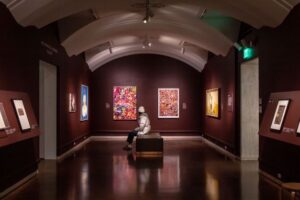
In the third gallery of the exhibition are familiar contemporary artists such as Rekha Rodwittiya
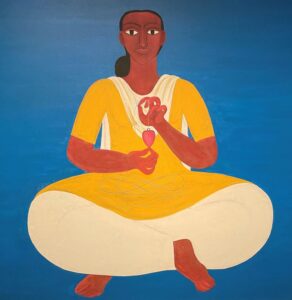
N. Pushpamala’s Motherland – The Festive Tableau, from the
Mother India project, 2009. Both Rekha and N. Pushpamela are redefining the historic goddess into contemporary women. In the case of Rekha she gives us an ordinary woman sitting with a powerful presence. In the case of Pushpamela she sends up the kitsch images of Mother goddesses in a hilarious historical recreation.
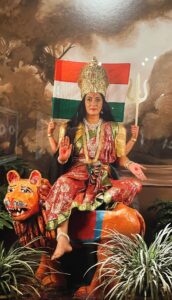
Mithila images by Jagadamba Devi of the the serpent goddess Naga Kanya suggest an entirely different perspective, more traditional as she is surrounded by her long serpent tail, but also very much in her own environment.
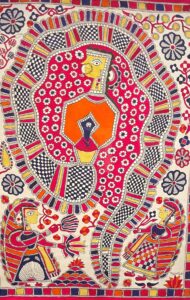
The quintessentially Indian Goddesses win out in the end with this gallery that spans tiny historical miniatures of dramatic scenes in which Durga takes on warriors and wins ( which were not allowed to be photographed). The contemporary artists images descend directly from those goddesses.
Outside the exhibition a scary neon Kali by Chila Kumari
Burman on the wall glows brightly 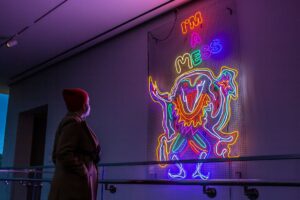
But the curator chose this image by Mithu Sen Miss Macho (Self Portrait), 2007 as the representative work for the exhibition.
Clearly a contemporary image of a trans woman, who looks out at us with her bold and beautiful eyes. By choosing this work the curator tells us that all that is new is old, and all that is old is still current in South Asian art. The concept of embodiment, of fluid gender, of powerful women has been around for a long time there, as well as all the social constructs that contradict that fluidity. While women in India may cover their heads with saris, they are some of the most powerful women I know. They still have Kali and Durga running in their veins.
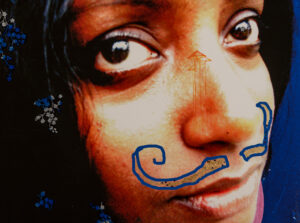
Asian Art Museum open 10-5 Fri – Sun
this article originally appeared in a shorter version here
http://www.artaccess.com/articles/12634620
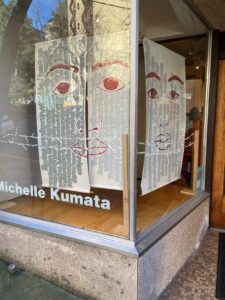
Bonfire Gallery “Michelle Kumata: Regeneration” to March 26
We are compelled to enter “Regeneration,” Michelle Kumata’s exhibition at the Bonfire Gallery by the banners in the gallery windows.
In the exhibition, Kumata is addressing the difficult subject of the long term legacies of the illegal incarceration of Japanese Americans during World War II.
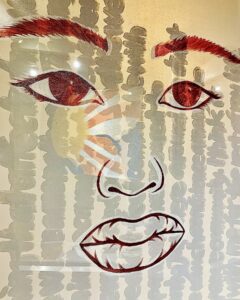 On the left of the entrance hangs “American Tragedy”, two banners depicting barely referenced facial features against a vague gray background behind real barbed wire. One has the face split between two banners, much as the experience of incarceration split the lives of those who were sent to those remote camps for up to four years.
On the left of the entrance hangs “American Tragedy”, two banners depicting barely referenced facial features against a vague gray background behind real barbed wire. One has the face split between two banners, much as the experience of incarceration split the lives of those who were sent to those remote camps for up to four years.
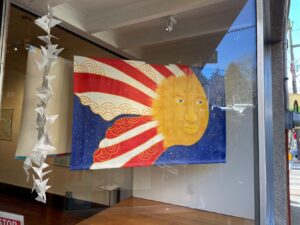
In the facing window, the banner “Shine” in brilliant color, suggests flying through the air, the Regeneration of the title of the exhibition.
Also in the window paper butterflies, made by a young Gosei (fifth generation) artist flutter toward the ceiling.
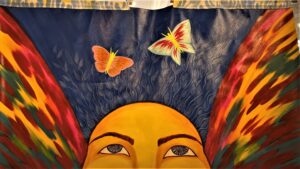
Inside the gallery “Butterfly Sun,” features a face that rises up
between butterfly wings.
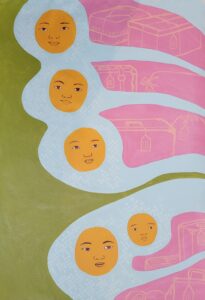
Nearby “what We Carry” also soars toward healing.
You can just see their luggage outlined in the wings.
As we watch the Ukrainians leaving their country with a single bag, it reminds us that they are being as brutally uprooted as the Japanese in 1942.

Michelle Kumata a three and a half generation Japanese American artist, explores the long term effects for her parents, the Sansei generation, who were born in incarceration during World War II as a result of Franklin Roosevelt’s Executive Order 9066. This generation is the last to have a direct connection to this abrupt violation of human rights.
It is a cautionary tale that refers directly to contemporary racism, forced exodus, and migration because of climate change.
“Regeneration” poignantly explores the ways in which incarceration survives into daily lives: the Japanese American community continues to be affected by the conditions that led to the incarceration.
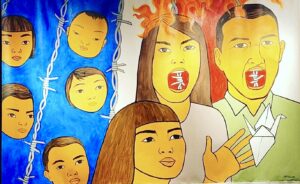
Michelle Kumata offers a multimedia approach to recovering memory and experiencing loss after decades of suppression. The largest expression of that, at the back of the gallery, is the lower section of the artist’s trademark work “Song for Generations.”
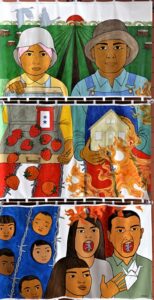
The entire banner represents a dignified husband and wife at the top, with their lush fields behind them, cleared from forest; in the next panel, strawberries fall to the ground and a house is burning. The bottom section, in the Bonfire exhibition, dramatically represents the ongoing pain of the incarceration with barbed wire in the open mouths of two Nikkei and flames around their heads. The strawberries become children, those born in the camps amidst barbed wire, but at the very bottom, a girl lets fly away a paper crane. You can see the whole mural in a small print nearby.
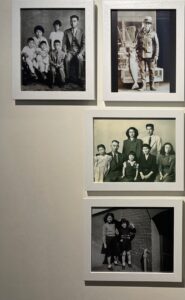
The next section of the exhibition features photographs of the artist’s maternal and paternal grandparents that document their lives before, during and after incarceration. The artist’s mother and father were born in the camps. These touching images speak to the real family stories of immigrants who had businesses and lives destroyed in 1942.
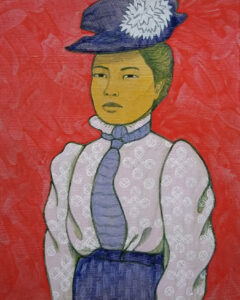
Gibson Garu
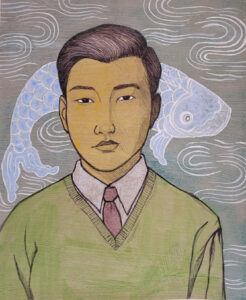
Koinobori
A similar feeling comes from paintings based on formally posed portrait photographs from the Takano Studio Collection from the late 1930s to early 1940s, called here “Nihonmachi portraits”
( Nihonmachi is the name of the Japanese business area of the International District before the incarceration.) The artist recreates a selection of these dignified portraits as paintings, again referring to lives before the camps.
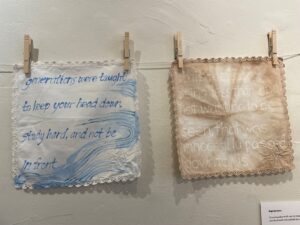
Facing these is a creative expression of memory: handkerchiefs with inscriptions such as “Generations were taught to keep your head down, study hard, and not be in front.”
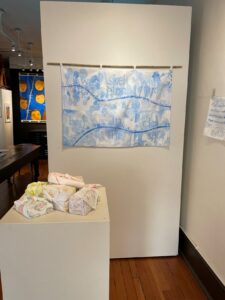
Nearby are “furoshiki” traditional Japanese wrappings for packages, here holding unspoken memories. Over generations as the artist states “the knots slowly loosen, releasing the pain, shame and anger. And we allow ourselves room to carve and define our own unique identities, to transform and fly.”
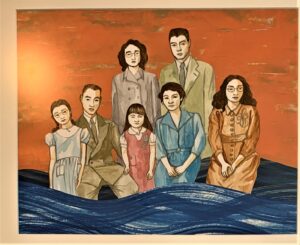
Resilience A Portrait of the Artists Maternal Grandparents
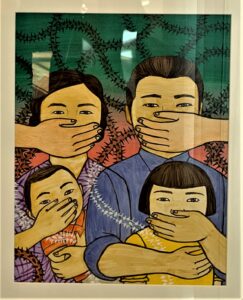
Be Quiet the alienation and oppression of Japanese Brazilians during World War II
In addition to all of these thoughtful approaches, a slide show of photographs alternates with quotes from a broad selection of members of our contemporary Japanese American community. The destruction of the heart of the Japanese community, Nihonmachi, and the unwillingness of survivors to speak of it are two major themes.

Bellevue Art Museum “Emerging Radiance, Honoring the Nikkei Farmers of Bellevue” to March 13
Michelle Kumata has a second major installation at the Bellevue Museum of Art “Emerging Radiance, Honoring the Nikkei Farmers of Bellevue.”
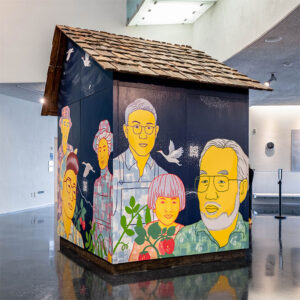
It features an immersive mural that uses augmented reality that enables us to actually hear three Nissei farmers of Bellevue tell their stories. The stories are based on interviews recorded in the Densho Digital Archive an incredible online resource that expands our understanding of the lives of those who were incarcerated.
YOu can hear the testimonies on her website
Michelle Kumata boldly experiments with representing the ongoing psychological damage of the original historical event of Japanese incarceration. She creatively makes audible what has been unspoken and makes visible what has been buried.
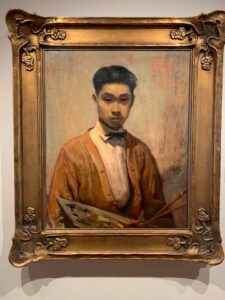 “Kenjiro Nomura American Modernist, An Issei Artist’s Journey” (Cascadia Art Museum, Edmonds, to February 20)
“Kenjiro Nomura American Modernist, An Issei Artist’s Journey” (Cascadia Art Museum, Edmonds, to February 20)
Kenjiro Nomura (1896 – 1956) came from Japan to Tacoma at the age of ten in 1907. while living in Tacoma as a child, he attended a Japanese Language school where he was fortunate to have a skilled teacher who taught him “graphic skill and developing aesthetic sensibility that served him well in adulthood.” ( Barbara Johns Kenjiro Nomura American Modernist p 14)
When he was barely seventeen his parents returned to Japan leaving him to fend for himself. He managed to not only survive but to find art training and then to be recognized as an artist. He moved to Seattle from Tacoma when he was 19 and began to study art with Fokko Tadama who had recently relocated from New York City bringing East Coast styles with him.
Nomura supported himself with his own sign painting business in the Nihonmachi, the heart of the Japanese immigrant community. As discussed in Barbara Johns excellent book of the same title as the exhibition, Nihonmachi provided a rich cultural environment.
Nomura made a major contribution to American scene painting with his 1930s urban street scenes. He carefully observed complex intersections in such familiar locations as 4th and Yesler.
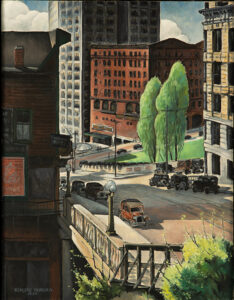
By the end of the decade Nomura was acknowledged as a major artist. His original take on the idea of American scene with its complex composition and spatial relationships makes his work distinct and in some ways more sophisticated than his contemporaries like Thomas Hart Benton and Grant Wood. Although here we see no obvious reference to his Japanese heritage, early training in Japanese painting affected his way of seeing in subtle ways.
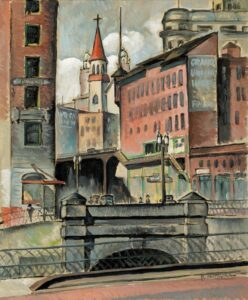
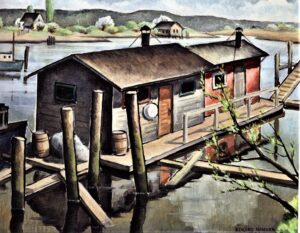
But suddenly it came to an end when on February 19, 1942, U.S. president Franklin D. Roosevelt signed the infamous executive order 9066 authorizing the relocation of all persons considered a threat to national defense from the west coast of the United States inland.
The order fell like an ax on the lives of people of Japanese descent regardless of whether or not they were citizens.
This February is the 80th anniversary of that order.
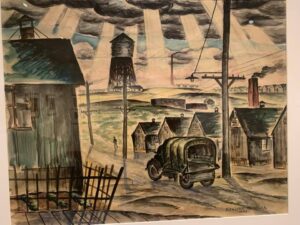
Nomura and his family were forcibly incarcerated along with 120,000 other people of Japanese ancestry. They first went to the State Fair Grounds in Puyallup,
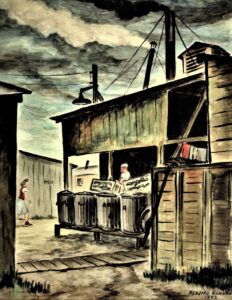
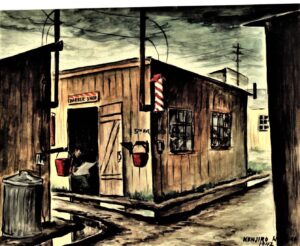
then to Minidoka, in desolate Hunt, Idaho.
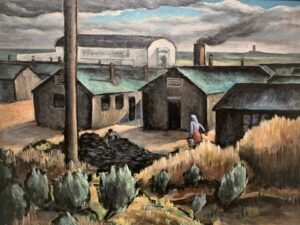
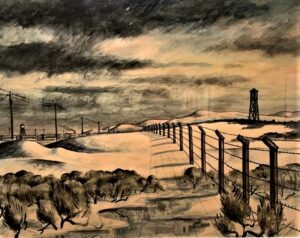
But Nomura never stopped painting! He made over 100 watercolors of the buildings, the people, and the natural environment in the camps. They remained rolled up in a closet until the 1990s.
Nomura’s son, George, brought work out of storage about 1990. It was shown at the Wing Luke Museum in Seattle in 1991 and toured for twenty years. Curator David Martin carefully chose twenty of them for this exhibition and orchestrated their donation to the Tacoma Art Museum.
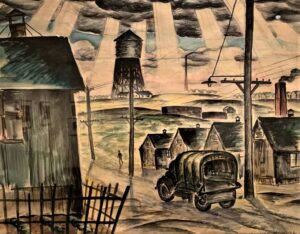
After years of internment, Nomura returned to Seattle. He then confronted severe personal challenges, most tragic of which was his wife committing suicide.
But with the encouragement of friends and probably also his second wife, he began painting again His work transformed completely, perhaps not surprisingly after so many traumas, into dynamic abstractions that he created up until his early death in 1956.In this too, he demonstrated a completely original approach.
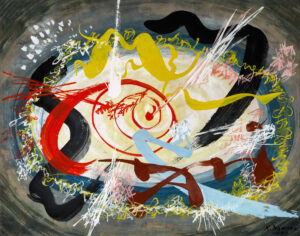
Folk Dance 1950 collection of Michael and Danielle Mroczek
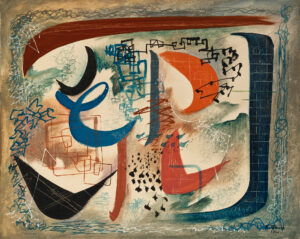
Shopping Center 1950 Collection of Lindsey and Carolyn Echelbarger, promised gift to Cascadia Art Museum
All images from the incarceration on in the collection of the Tacoma Art Museum.
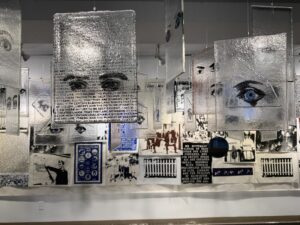
photograph by Henry Matthews
Christina Reed’s exhibition “Reckoning” confronts us with our own whiteness and oblivous racism head on and with ingenuity.
The exhibition consists of three parts. The first is Reflection, a wall filled with large black and white prints based on historical photographs of white people: juries, business men, families, picket fences, interspersed with the words of the declaration of independence, maps of redlining.
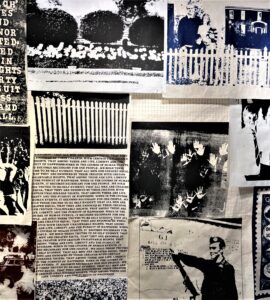
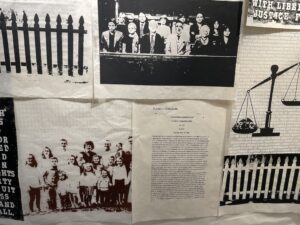
The white people are passive, but collectively they create a wall of oblivious privilege. Interspersed with the images are repeated quotes from the declaration of independence underscoring the racism of the white founders as they wrote of equality even as slavery was perpetuated and black people denied all rights.
Inserted every few feet is a mirror. We can see our own white faces as part of the white racist gaze, or for a visitor of color, surrounded by this wall of privileged exclusion.
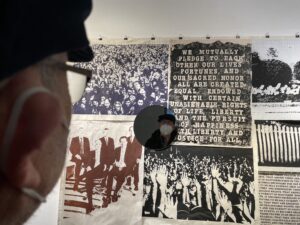
We turn from this immersion in whiteness to the second part of the installation, Regard: White Gaze. Thick glass squares hanging from the ceiling painted with blue eyes that gaze directly at us. A literal white gaze, the glass feels claustrophobic as we observe it more closely, suggesting the feeling of being watched, judged, monitored, and even threatened simply by the act of looking. It is very difficult to walk through this intense forest of glass panes, another wall of privilege, so we walk around it.
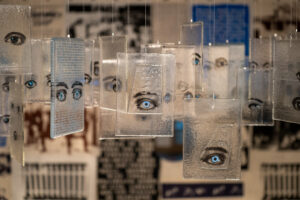
Photograph by Susan Fried

photograph by Henry Matthews
The third part of the installation Repair suggests actions to counter racism. There is going to be a closing on February 17 5-7 pm(hopefully) in which people wear signs that have references to various aspects of ways to counter racism. On one side of the sign is an oblique reference. You have to turn the sign over in order to know what it means. In other words you have to do more than look at the sign.
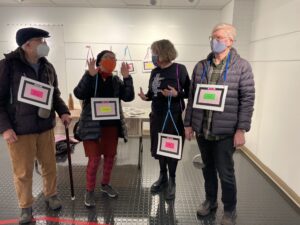
Then once you turn it over a wide range of possible ways forward are offered some educational, some personal, some joining with others. They include references to the 1619 project, a history of slavery and the roots of racism. Another explains red lining, a third “12 out of 18” lists the 12 Presidents out of the first 18 who owned slaves. Other actions suggest observing microaggressions, euphemisms. And of course speaking to our elected representatives about racism is one of the suggestions and supporting diverse cultural organizations. Revolution is not included but volunteering on projects related to the Criminal Justice System is one of the more specific community actions.
The Rosetta Hunter Art Gallery Seattle Central College 1701 Broadway, 2BE2116 Seattle, WA 98122
206.934.4379 Hours10:00 a.m. to 2:00 p.m. Monday through Thursday Admission is free. They have briefly closed because of COVID concerns but new dates are February 8 – March 24
Christina Reed received support for this project and did much of her research at the historic home and library of the James and Janie Washington Cultural Center 1816 26th ave in the Central District. If you want to know more about this important artist, come to the unveiling of a bronze statue of Dr. James W. Washington and the restored “Fountain of Triumph” Washington’s last public monument. The “Fountain,” formerly located on 23rd ave, addresses salmon migration as a metaphor of the difficulties of survival for African Americans. The Event will be at 24th and Union part of the newly built Midtown Center, February 26, 2022, 6:30pm to 8:30pm. Call the Washington Foundation for Information 206-709-4241.
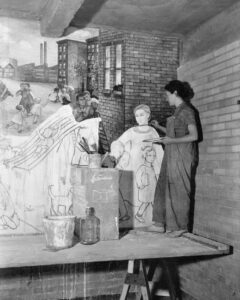
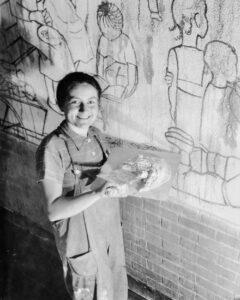
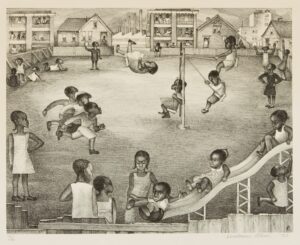
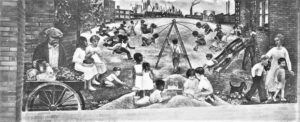
This is a detail of the center of Lucienne Bloch’s mural
“Cycle of a Woman’s Life” sponsored by the WPA in the mid 1930s. Above are photographs of Bloch painting the mural.
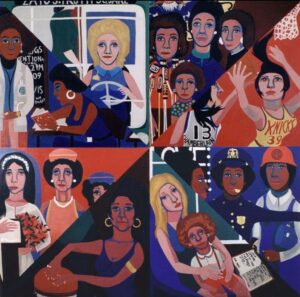
Here is Faith Ringgold’s mural “For the Woman’s House,” also painted in a woman’s prison, in 1972. It was her first public art commission.
Both artists consulted inmates about the content of the mural.
Bloch’s mural showed an ideal life of children playing happily together in a playground.
Ringgold shows careers that the women thought were “outside their reach” as the NYTimes article puts it. Not sure if that is accurate, why not careers they might want to aspire to have when they got out of prison.
Both artists wanted to alleviate the dreadful environment in which the inmates found themselves.
Bloch’s mural was covered up almost immediately, the claim of the administrators was that it gave the inmates false hope. when the prison was demolished, it disappeared forever.
Ringgold’s mural at Rikers has been moved several times. It is currently being moved to the Brooklyn Museum.
Art Historian Michele Bogart stated ” I keep wondering if they are doing a disservice to the people who are still at Rikers.”
Both of these artists believe that art can make a difference.
Bloch worked with Rivera on his mural at Rockefeller Center before it was demolished.
Ringgold has spent her whole life engaging in art with social content. Early in her career she created work on fabric she could roll up and bring with her to save the cost of shipping,so, she said she could collect that money as an honorarium.I remember hearing her speak about this in Austin Texas in 1978.
Bloch worked for the WPA during the 1930s, then spent her whole life making murals and teaching workshops on mural making. I was fortunate to attend one of those late in her life in El Paso, Texas, as well as to go to a one person show she had in California. Here is Bloch with her lifelong love and partner in art Stephen Dimitroff in El Paso.
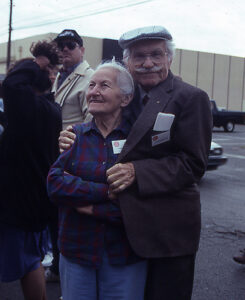
The real tragedy of this story is the prison itself. The prison where Bloch worked was intended to be an ideal new prison, but it deteriorated into a dreadful place and was demolished in the 1970s
Ringgold’s mural was moved several times, after it was threatened, then it was also covered up.
We all know how ghastly Rikers is as a prison.
Where can art fit in these places? I know of artists who do art in prisons with the prisoners, art and poetry, and drama, and other creative activities. this may be more productive than painting something on a wall, but the dreariness of these places is hard to fathom.
There are no easy answers. But I respect both Bloch and Ringgold as well as the government entities that sponsored them, for trying to add something positive to a dreadful place.

Carrie Mae Weems the Shape of Things
included 7 parts!
It was in fact partially a retrospective
The first installation at the Park Avenue Armory in New York City is a set of megaphones in the large space. this called “Seat or Stand and Speak” was an opportunity to sound off or not, as we began to think about our current times. Mostly people did not sound off.
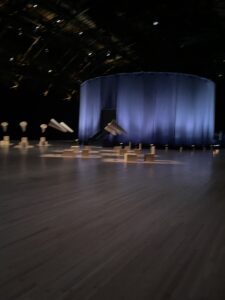
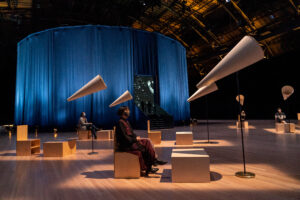
Photo Credit: Stephanie Berger
The next stop was inside the blue cyclorama you see in the background: called Conditions, A Video in 7 parts with original music by Jawwaad Taylor.
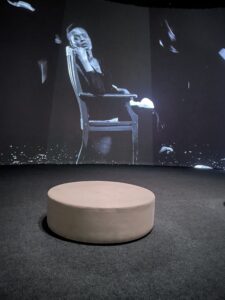
This image of performer and choreographer Okwui Okpokwasili sitting in a chair with papers falling like leaves around her begin the video. As Aruna D’Souza wrote in the New York Times: “Weems’s voice, with its deep, round tones, tells us that to navigate the now, “she needs to look back over the landscape of memory.”
Weems stated in the press release:
“I am fascinated by 19th century media, so for the Drill Hall I created a cyclorama that contains a new film that pits the rise of the right along with its puppeteers, clowns, jokers and two-faced speakers & spies, charlatans & prophets of fake news, conspiracy theorists against the emerging forces of progress. In this world, ‘normal’ is turned on its head and all bets are off.
“It is a time of murder, mayhem and mass protest and when covert operators of corruption bear their heads for all to see. My work centers on what happens when all facades are stripped away, and the people are left standing face to face with the realities of our time.”
The artist also narrates the film which is 40 minutes long. As Marley Marius put it in Vogue: ( I didn’t find this information anywhere)
“Weems mostly narrates these vignettes, employing her richly resonant speaking voice to discuss, among other things, the ubiquity of police brutality (“Imagine the impossible. Imagine the worst of the worst. And know that it is always happening”).”
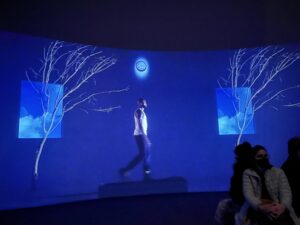
Here is one still from the film of a black man walking, probably referring to the recent murder of Ahmaud Arbery, but it could be any black man. The recording of the woman who called the police in Central Park against a black man birding can be heard in the background of the two women seated in silhouette at the top of the post and here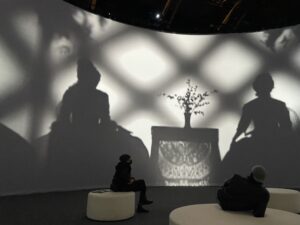
Shadow puppets of slave owning women.
Another theme was migration, both in boats and on land.
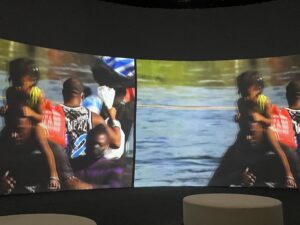
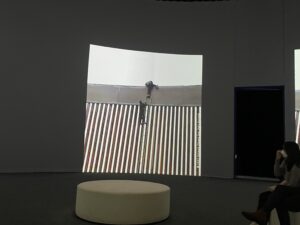
and the border fence on our Southern border.
But there were images from the treacherous crossing of the Mediterranean. You can see it is footage from the news. In front is one of the seats where we watched the film, keeping in mind that we were completely surrounded by the images as in the 19th century Cyclorama.
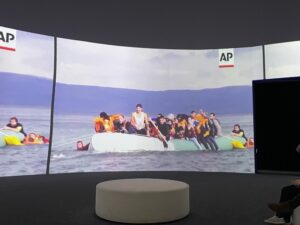
The video also included some historic images of circus performers and a clown ( evidently referring to T, keeping in mind that clowns are smart people who pretend to be someone they are not)
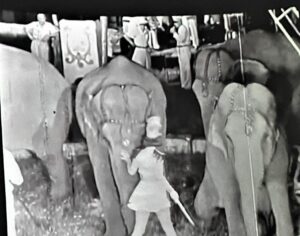
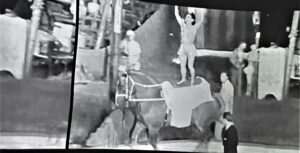
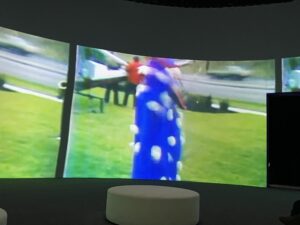
The clown is blurry, but he was moving a lot, and it seems appropriate somehow that he is hard to see.
The January 6 riot was also included and below a reference to white racists from the earlier Civil Rights era or before.
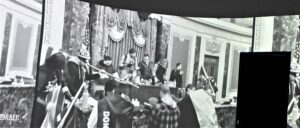
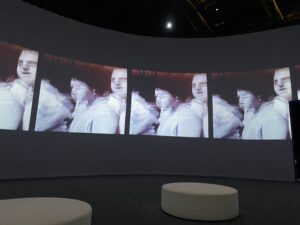
There were people silently marching, with no signs. I wondered if they represent BLM marchers, although we all had signs, or is it a staged march representing protests against injustice everywhere. The artist photographed them in summer 2020
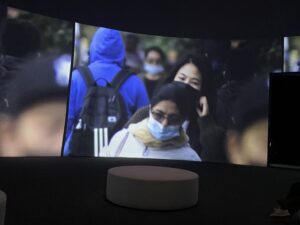
There was a lengthy segment of various people standing in the rain I don’t know what they mean. Suggestions welcome. It has the title Conditions
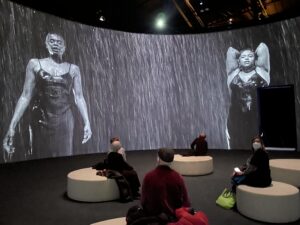
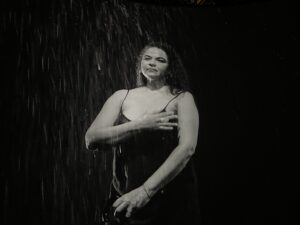
As well as numerous silhouettes of people marching
Finally I give you this repeated image of three women holding up globes.
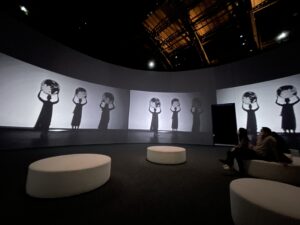
There were three more segments to the exhibition. Here is a diagram of the whole piece to orient you. I have so far mentioned A and B
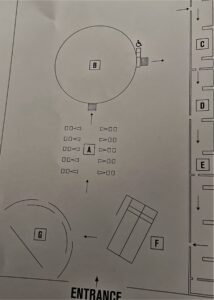
A long corridor (on right of diagram ) started with
C “Its Over – A Diorama, with memorials honoring some of those who have died. The theme of the globe reappears
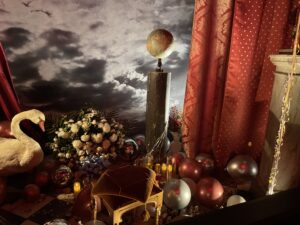
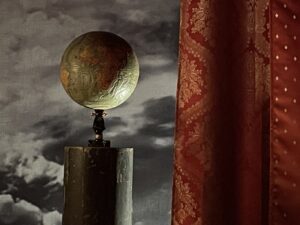
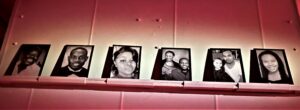
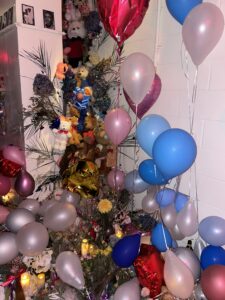
A segment from earlier works
B Missing Links from 2004 various animals such as zebra, elephant sheep and wolf, dressed up in fancy clothes, In the brochure an earlier version is called The Louisiana Project 2003
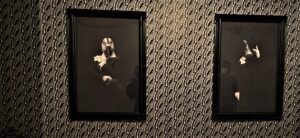
and E The Weight 2021, more globe/balloons on African heads.
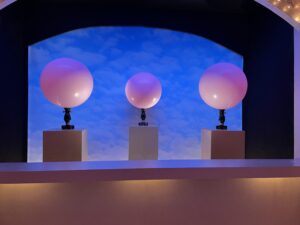
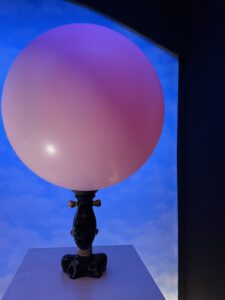
OK that’s three segments.
There are two more!
F was like a cabaret in a darkened room called Lincoln, Lonnie and Me 2014, it included the Gettysburg Address, in what the press release calls a Pepper’s ghost illusion with music by Jason Moran,
I like that my image looks like a ghost! Lonnie is Lonnie Graham an artist and activist.
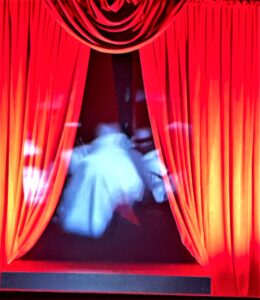
This second image is from the press photos
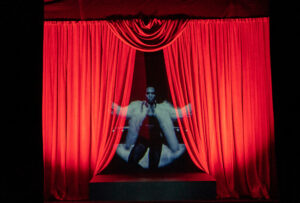
Photo Credit: Stephanie Berger
Nearby in the darkened room were carnival promoters, another globe
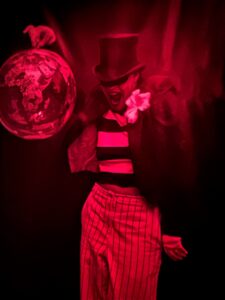
and finally
G All blue, A Contemplative Site 2021
It was an old door at the top of some steps with a full moon. Here it is
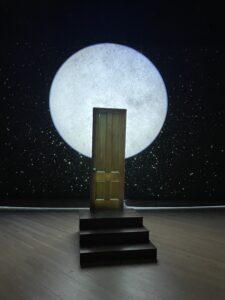
and with me 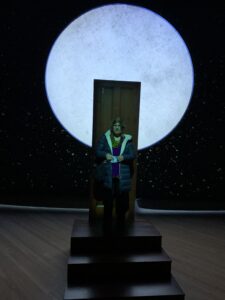
I am trying to assimilate this incredible multipart installation. It is meditative, angry, hopeful, historical, contemporary, a compendium of images that together speak to our moment, our fragile moment in history. I am glad that Carrie Mae Weems seems to see the forces for good as stronger than those for evil. Or do we see a Civil War here that is still being fought?
In these dark days coming up to the anniversary of the attack on the Capitol, it is hard to believe in that, but if we all stay actively resisting evil in what ever small or large way that we can it will make a difference. Weems leaves us to figure that out for ourselves.